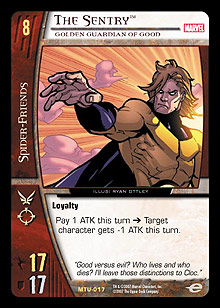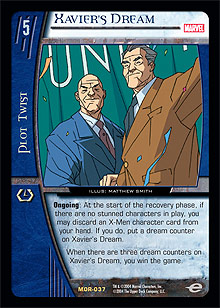
|
The Sentry™
Card# MTU-017


While his stats aren’t much bigger than those of the average 7-drop, Sentry’s “Pay ATK” power can drastically hinder an opponent’s attacking options in the late game.
Click here for more
|
|
|

|
|
|

 |
 |
|
|
| |
Vs. System is filled with wildly varied strategies. Whether constructing a deck at home or drafting a specific team in a tournament, there will be some tough choices to make. These strategy decisions can be either risky or safe, depending on your personal style and preferred method of victory.
Some cards are inherently safer than others. Thing, Ben Grimm is solid stone with no risk involved. He is big for his cost and has no specific recruiting requirements. His ability is not flashy, and it can be useful in Sealed Pack–format tournaments. However, safe cards like this can also be utilized in risky strategies. Since Thing, Ben Grimm costs 3 to recruit, A Child Named Valeria can protect him while he opens the door to Four Freedoms Plaza. This combination creates a strategy that’s been termed Child Lock. Since so many cards need to come together to make it work, this strategy is not inherently safe.
By following the Professional Circuit and studying the winning decks on the Internet, you can discover card combinations and strategies that win consistently. These can be considered safe. During the first six months of Vs. System competitive play, there have been a mind-boggling number of successful deck combinations. Well over 60 percent of the available Vs. System cards have been included in a deck that won money at one time or another. This kind of diversity is unheard of in the TCG community. It’s hard to believe that there is a TCG Professional Circuit with so many viable competitive cards and strategies.
Even with this vast array of possibilities, there is a comforting pool of safe strategies in the metagame. Some players prefer using only proven decks that are published on the Internet and in magazines after someone else develops the strategy and wins with it. In the Vs. System, there are a large number of proven deck archetypes and an even larger variation of card combinations within those archetypes. Even when building a deck found on a website or in a magazine, there will still be several personal strategy decisions to make. Brotherhood decks have won a large percentage of the PCQs and $10K tournaments to this point, but there are still many different ways to use them. You can play Little Brotherhood with The New Brotherhood’s ATK-enhancing power, Big Brotherhood with its synergy between Lost City and Avalon Space Station, or some combination of both (Medium Brotherhood) if you like both strategies or if you can’t decide between the two. All three varieties have won money in the $10K tournaments.
There is also an untapped ocean of winning abilities and combinations that do not appear very often on the winning lists. These strategies lie on the risky side of the Vs. System. Many players love to live in that dangerous dimension of the game. The risk-loving player is not as concerned with the strategies that have proven successful. Many less well-known cards can bring spectacular and memorable victories. These cards and the combinations that they create may not be consistent as their safer counterparts, but their rewards can be just as great.
The payoff for a risky strategy is not merely monetary. There is a special thrill that can only be felt in the successful execution of an unusual and surprising victory. It takes courage to try something different and dangerous. Risky strategists who are successful often get more attention from the community than the safe, consistent winners, and they can gain a large measure of respect. Originality and creativity can be far more satisfying than safe victory.
One of the most risky cards (and my personal favorite) is Primary Directive. This plot twist can lead to spectacular victories, yet it has never been included in a published money-winning deck.  At the Origins $10K tournament in Columbus, Ohio, Primary Directive allowed me to draw all 60 cards in my deck on my fifth or sixth turn, and I did so in three different games that day. At the time, DC Origins was not tournament legal, so I did not have Batman, The Dark Knight to benefit from the 30 to 40 cards in my hand. Luckily, Bastion loves to turn extra Sentinel characters in your hand into an all-you-can-eat buffet. However, because of the extreme risks involved with this strategy, I finished the tournament with a 4-4 record, out of the money. At the Origins $10K tournament in Columbus, Ohio, Primary Directive allowed me to draw all 60 cards in my deck on my fifth or sixth turn, and I did so in three different games that day. At the time, DC Origins was not tournament legal, so I did not have Batman, The Dark Knight to benefit from the 30 to 40 cards in my hand. Luckily, Bastion loves to turn extra Sentinel characters in your hand into an all-you-can-eat buffet. However, because of the extreme risks involved with this strategy, I finished the tournament with a 4-4 record, out of the money.
Many “ifs” are involved in an unusual strategy, and Primary Directive is no different. A strong Sentinel deck should be able to win without Primary Directive. If all of an opponent’s characters are stunned on the fifth turn, the game should be well in hand for the Sentinel player. If the strategy is aiming at recognizing the full potential of Primary Directive, where each massive card-drawing effect produces another copy, which produces another copy, which produces another copy, which draws the whole deck, there must be a large number of Army Sentinel characters in play under your control. The swarm of characters can be stunned, but they must be in play. However, if there are that many small characters around, the deck becomes very vulnerable to Flame Trap, Total Anarchy, and Scarecrow. If you can handle those ifs, and the severe beatings that can occur, then go for the thrill.
Xavier’s Dream is another dangerous card that causes thrill-seeking and risk-taking players to lose lots of sleep. The designers of the game must make alternate win conditions like this extremely risky. If Xavier’s Dream was safe and consistent, no one would use any other strategy. Playing a deck that includes Xavier’s Dream becomes a real nightmare in a world filled with Foiled; Have a Blast!; and Batman, World’s Greatest Detective. Those cards can destroy the dream in an instant. The designers of the game must make alternate win conditions like this extremely risky. If Xavier’s Dream was safe and consistent, no one would use any other strategy. Playing a deck that includes Xavier’s Dream becomes a real nightmare in a world filled with Foiled; Have a Blast!; and Batman, World’s Greatest Detective. Those cards can destroy the dream in an instant.
Even without the dream-hating destruction, Xavier’s Dream is difficult and dangerous. In order to put a counter on the plot twist, all players need to have no stunned characters. That is a rare situation after the fifth turn—not impossible, but very unusual. Two unusually risky players designed a strategy that actually got Xavier’s Dream to win its way to a Top 8 finish in a Pro Circuit Qualifier, and they may become legends for it. Alexander Burns and John Rich used exhausting effects such as Dazzler and Banshee to control the game long enough for Jean Grey, Phoenix Force to clear the board of all characters. When all characters are back in their owners’ hands, there are no stunned characters in play.
In practice, this strategy used Rogue, Power Absorption to create a faux–Phoenix Force effect so that Jean Grey could be recruited again the next turn. The entire room buzzed all day and night as we watched Xavier’s Dream win on that level for the first time. That was, of course, before DC Origins made it much harder to keep the dream alive. Xavier’s Dream has still not been included in a published money-winning deck, but Top 8 finishers in Pro Circuit Qualifiers are awarded extended art promotional cards. Alec and John also won the distinction of creating perhaps the riskiest PCQ Top 8 deck ever.
If you want to shake up your local metagame and cause your opponents to talk about the way you beat them for days afterward, dangerous strategies and cards like Primary Directive and Xavier’s Dream are for you. If you care more about consistent victory, find a proven strategy that suits your personality. Play the Vs. System your way. You will be well rewarded.
Rian Fike is also known as stubarnes, his screen name at vsrealms.com. If you have a favorite risky card or strategy that you would like to see covered in a future article, drop him a line at fullbodytransplant@hotmail.com.
|
| |
| Top of Page |
|
 |
|
|
 |